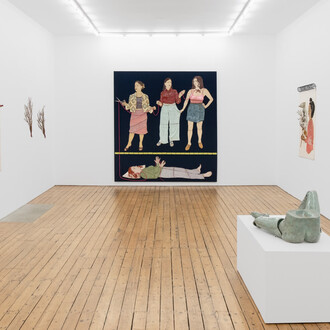I know the love that passes from the fingers into the folds, the holes, the swellings. –Jean Genet
Two- and four-way stretch fabrics were brought to market in the 1960s as novel developments on neoprene; the spandex and elastic now known commonly as Lycra®. They display the contemporary advantages of being pliant, supportive and expansive, even humorously encompassing the human figure at its leisure. Where the wetsuit, foamed with nitrogen gas, insulates an isolated body from external ocean temperatures, dense microfiber machined into specialised enveloping structures streamline those extra soft contours below a surface layer of current trends. Traditionally, the chiaroscuro of draped and deeply piled fabric in Northern Renaissance painting – copped from the complex marble clothing of classical sculpture – expressed status in rich velvets and high-sheen satins that were strewn, according to the faculties of the artist, magnificently and maddeningly about. Shapeliness of esteem and character might assume environmental proportions, a direct exponent of one’s own lavish flow of robes.
If today’s industrial soft plastic cloth is worn so closely to the skin, its atmospheric effect is reduced to terse description: stately mounds and ungainly limbs optically obscured by wet-look, matte-athletic, python-lacquer finishes. Instead of volume, the tensile subject aspires to a back-end viral aesthetic, idealised in the anguilliform flickering of an eel, or inky iridescence of a seeping oil slick. Here, the dialectic between concept and matter collapses in the manufacturing process; polymer extraction technologies, in their potential for high impact pollution, risk an insensate and pervasive deadliness. Overwhelming the tally of containment barrels, and a blowout preventer, the latest spill surges incorrigibly on jet streams, rip tides and trade winds, emulsifying and multiplying with seawater droplets, adhering to organic matter in a sinking sediment. So long as the shoreline is our strictest measure, the depth of such crude material influence remains ill acknowledged by vertebrate production chains.
Seen swelling via satellite, such a leak appears as some unruly Rorschach, an epidermal blemish projected from the earth’s aged, molten core. The Gulf (and other) reservoirs still suffer for civilization and its profiteering fashions; on the order of these damages, what escrow could be great enough for the Egret, or anyone else?
Text by Kari Rittenbach
Alice Channer (b. 1977, Oxford, UK) lives and works in London. Her work is currently exhibited in the following group shows: nature after nature, Fridericianium, Kassel; Pool, Kestnergesellschaft, Hannover; The Cable Guys, Future Gallery, Berlin (all in Germany) and ‘Chat Jet – sculpture in reflection Part 2’ at Künstlerhaus KM-Halle für Kunst & Medien, Graz, Austria. Recent solo exhibitions include: Soft Shell, Kunstverein Freiburg, Germany; Invertebrates, The Hepworth Wakefield, UK (both 2013); Cold Blood, Lisa Cooley, New York and Out Of Body, South London Gallery, UK (both 2012); Body-Conscious, The Approach, London, UK (2011). Recent group shows include The Encyclopedic Palace, 55th Venice Biennale, Venice, Italy; Frieze Sculpture Park, Frieze Art Fair, London, UK and Cookbook: l’art et le processus culinaire, Palais des Beaux‐Arts, Paris, France (all 2013); In June, Alice Channer will present a solo project at Art Basel Unlimited, Basel, Switzerland. In 2015 she will have solo exhibitions at Aspen Art Museum, Aspen and Lisa Cooley, New York (both USA).



















